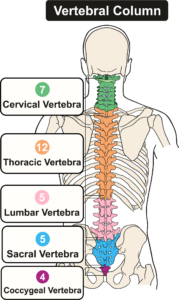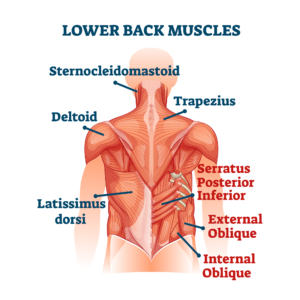
The back has a complex structure made up of the spine, discs, nerves, muscles, ligaments and tendons that all work together. The spine contains 26 stacked vertebrae with discs in between to provide cushioning and allow flexibility. The spinal cord runs through the center, with nerves extending through vertebra holes connecting to many parts of the body including the hands and feet. The most common areas for spinal issues are the cervical and lumbar spine (neck and lower back).
 Ligaments hold the vertebrae together, with tendons attaching muscles to the spinal vertebrae which allow for movement. The back has 40 muscles that mirror each other on each side of the body. These work intricately together to move specific areas of your back, shoulders, neck, arms and pelvis. The source of neck or back pain can vary and include muscle strain, ligament sprain, herniated discs, spinal stenosis, or osteoarthritis. If the pain is caused by a muscle, at home remedies are helpful with rest and heat/cold packs often being a sufficient treatment. Stretching and exercising back muscles are useful deterrents to back muscle issues, or for reinvigorating healed muscles or tendons.
Ligaments hold the vertebrae together, with tendons attaching muscles to the spinal vertebrae which allow for movement. The back has 40 muscles that mirror each other on each side of the body. These work intricately together to move specific areas of your back, shoulders, neck, arms and pelvis. The source of neck or back pain can vary and include muscle strain, ligament sprain, herniated discs, spinal stenosis, or osteoarthritis. If the pain is caused by a muscle, at home remedies are helpful with rest and heat/cold packs often being a sufficient treatment. Stretching and exercising back muscles are useful deterrents to back muscle issues, or for reinvigorating healed muscles or tendons.
Muscle strain happens when muscle fibers are stretched to the point of injury. Sprains, different from strains, happen when ligaments are torn, and can happen from overuse or sudden injury. Rotator cuff tears in the shoulder are a more common tendon tear, and can be treated with or without surgical intervention, with many recovering with nonsurgical treatments. Herniated discs cause pain by pinching a nerve adjacent to the spine, and depending on the location, can cause pain in the back, neck, legs, or arms as well as numbness or tingling. Treating herniated discs involve managing pain levels and rehabilitation through medication, injections, and physical therapy. Surgery may be considered if conservative treatment options don’t improve symptoms over a period of time.


